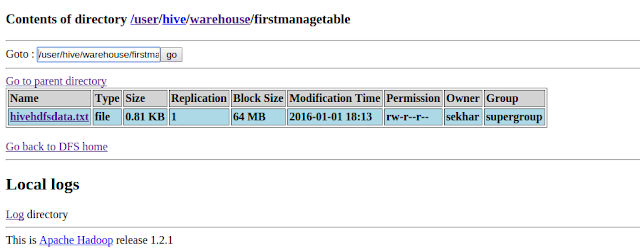Question :
Op/ of the Below question is FRED
Here I am attaching the code.
ManagerRelation.java
Op/ of the Below question is FRED
Here I am attaching the code.
1 2 3 4 5 6 7 8 9 10 11 12 13 14 15 16 17 18 19 20 21 22 23 24 25 26 27 28 29 30 31 32 33 34 35 36 37 38 39 | public class BinaryNode { private String value; BinaryNode(String value){ this.value = value; this.left = null; this.right = null; } public String getValue() { return value; } public void setValue(String value) { this.value = value; } public BinaryNode getLeft() { return left; } public void setLeft(BinaryNode left) { this.left = left; } private BinaryNode left; public BinaryNode getRight() { return right; } public void setRight(BinaryNode right) { this.right = right; } private BinaryNode right; } |
1 2 3 4 5 6 7 8 9 10 11 12 13 14 15 16 17 18 19 20 21 22 23 24 25 26 27 28 29 30 31 32 33 34 35 36 37 38 39 40 41 42 43 44 45 46 47 48 49 50 51 52 53 54 55 56 57 58 59 60 61 62 63 64 65 66 67 68 69 70 71 72 73 74 75 76 77 78 79 80 81 82 83 84 85 86 87 88 89 90 91 92 93 94 95 96 97 98 99 100 101 102 103 104 105 106 107 108 109 110 111 112 113 114 115 116 117 118 119 120 121 122 123 124 125 126 127 128 129 130 131 132 133 134 135 136 137 138 | import java.util.*; public class ManagerRelation { private static Set<BinaryNode> treeNodes = new HashSet<BinaryNode>(); private static BinaryNode root; public static void main(String[] args) { try { ManagerRelation mr = new ManagerRelation(); Scanner in = new Scanner(System.in); int _count; _count = Integer.parseInt(in.nextLine()); mr.readInput(_count, in); } catch (NumberFormatException ne) { ne.printStackTrace(); } catch (Exception e) { e.printStackTrace(); } } private BinaryNode commonManager(BinaryNode root, String s1, String s2) { if (root == null) { return null; } if (root.getValue().equalsIgnoreCase(s1) || root.getValue().equalsIgnoreCase(s2)) { return root; } BinaryNode left = commonManager(root.getLeft(), s1, s2); BinaryNode right = commonManager(root.getRight(), s1, s2); if (left != null && right != null) { return root; } if (left == null) { return right; } else { return left; } } private boolean isNodeExists(String value) { Iterator<BinaryNode> treeNodesIterator = treeNodes.iterator(); while (treeNodesIterator.hasNext()) { BinaryNode n1 = treeNodesIterator.next(); if (value.equalsIgnoreCase(n1.getValue())) { return true; } } return false; } private BinaryNode getNode(String value) { BinaryNode node = null; Iterator<BinaryNode> treeNodesIterator = treeNodes.iterator(); while (treeNodesIterator.hasNext()) { node = treeNodesIterator.next(); if (value.equalsIgnoreCase(node.getValue())) { return node; } } return node; } public void readInput(int count, Scanner in) { //read the employee1 first name for whom we need to find the ancestor String employee1 = in.next(); //read the employee2 first name for whom we need to find the ancestor String employee2 = in.next(); //Define a set contains unique employees names, this set count should not be more than count of // unique employees Set<String> uniqueEmployees = new HashSet<String>(count); uniqueEmployees.add(employee1); uniqueEmployees.add(employee2); while (uniqueEmployees.size() <= count) { StringBuffer sb = new StringBuffer(); for (int i = 0; i < 2; i++) { sb.append(in.next()); if (i == 0) { sb.append(","); } } String[] relationLine = sb.toString().split(","); uniqueEmployees.add(relationLine[0]); uniqueEmployees.add(relationLine[1]); if (uniqueEmployees.size() <= count) { constructRelationTree(relationLine[0], relationLine[1]); } } BinaryNode node = commonManager(root, employee1, employee2); System.out.print(" FOund " + node.getValue()); } private void printRelationTree(BinaryNode root) { if (root == null) { return; } System.out.print(root.getValue()); printRelationTree(root.getLeft()); printRelationTree(root.getRight()); } private BinaryNode constructRelationTree(String s, String s1) { BinaryNode node; if (isNodeExists(s)) { node = getNode(s); } else { node = new BinaryNode(s); treeNodes.add(node); if (root == null) { root = node; } } if (node.getLeft() == null) { BinaryNode n1 = new BinaryNode(s1); node.setLeft(n1); treeNodes.add(n1); } else { BinaryNode n2 = new BinaryNode(s1); node.setRight(n2); treeNodes.add(n2); } return node; } } |









